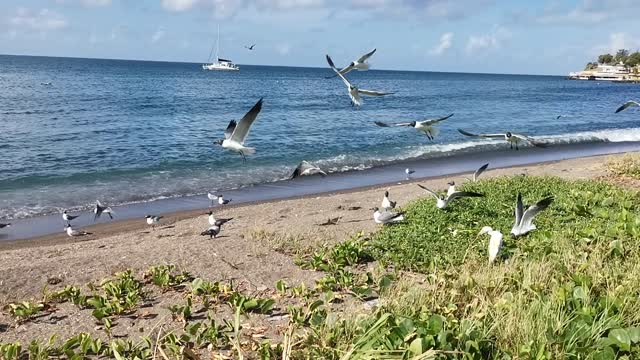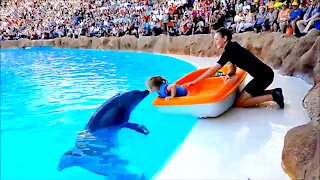Premium Only Content

Seabirds Flocks On The Seashore For Food
Multiple Seabirds gather on the seashore where meals are plentiful. There are Pelicans, Seagulls, Gaulin and shorebirds all together eating scraps of fish that we're left behind by the fishermen. Watch what happens next in this video.
A seabird can be defined as a bird that makes its living primarily in the ocean, beyond the intertidal or surf zone.
Seabirds are beautifully adapted for life in the ocean. Generally, they have dense, waterproof feathers; layers of fat; and a desalinization system to remove excess salt. Some, like the Common Murre, stick fairly close to home throughout their lives; others, like some albatrosses and shearwaters, literally wander around much of the North Pacific over a year. Their body shapes reflect their life histories:
The stubby wings and potato-shaped body of the Marbled Murrelet are unsuitable for long-distance flying but great for pursuit diving underwater, giving them a three-dimensional feeding environment. This is the right design for colder, northerly waters where prey forms dense schooling balls.
Conversely, the long, slim wings, relatively small body, and heightened sense of smell of the Laysan Albatross are perfect for long-distance flying to find scattered prey at the ocean’s surface. This is the right design for warmer, open-ocean waters where prey is more widely scattered at the surface.
Most seabirds are long-lived (some over 50 years) and don’t start to breed until they are 5-10 years old. These characteristics may be an evolutionary strategy to cope with their highly variable ocean environment: it gives birds a chance to spend several years learning how to find prey over many seasons before attempting breeding, and, gives adults many chances to successfully rear young who reach reproductive age themselves.
Seabirds play important roles in marine, intertidal, and terrestrial environments because they forage throughout the world’s oceans, consume an estimated 7% of marine productivity, and are a food source for other marine and terrestrial predators and humans. On land and near shore, seabird guano fertilizes terrestrial, intertidal and subtidal zones, enhancing local plant growth.
-
 1:37
1:37
Expert Videos Magnetic Media
3 years agoDolphin kisses a little girl and brings her a gift
46744 -
 0:06
0:06
saroj369
3 years agoFemale Pheasant Gathering
201 -
 2:03
2:03
HANYMata
3 years agoSeagulls gathering in park.
2 -
 0:11
0:11
kirikigwit
3 years agoNATURE: Seashore
330 -
 2:20
2:20
WFTS
3 years agoSummer Gathering Essentials | Morning Blend
14 -
 2:04:52
2:04:52
Kim Iversen
7 hours agoElon's Pumping Out Babies Like They're Tesla Model 3's | EU Panics Over Peace Talks, Wants More War
91.4K106 -
 1:05:35
1:05:35
Man in America
10 hours agoFort Knox & Trump’s Secret Gold Move—The Financial Reset NO ONE Is Ready For?
46K23 -
 2:21:20
2:21:20
Robert Gouveia
7 hours agoTrump Goes to SCOTUS! Judge CAVES on DOGE? Fani Willis Not Happy!
82.3K25 -
 20:41
20:41
Stephen Gardner
7 hours ago🔥You Won't BELIEVE What JUST Happened To Don Trump Jr.!!
79.4K125 -
 58:00
58:00
The StoneZONE with Roger Stone
5 hours agoEuropean Leaders Resist Trump Peace Overtures To Their Own Demise | The StoneZONE w/ Roger Stone
56.8K11